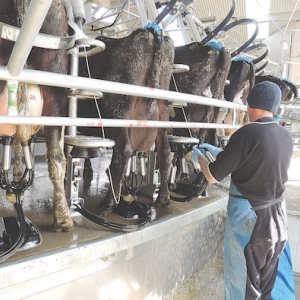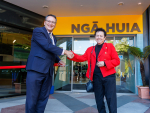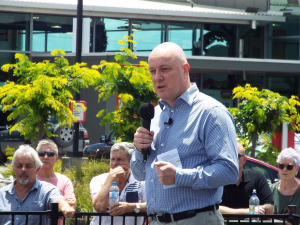The series of seven leptospirosis clips, most about six minutes long, aims to provide information to protect people and stock from the bacterial disease that hospitalises 50 each year, says the university.
Dr Jackie Benschop of the university’s Institute of Vet, Animal & Medical Sciences, says the series is important because so many cases of leptospirosis are unrecorded. It’s estimated incidence is about 43 times higher than the number of notified cases, due to misdiagnosis or issues with accuracy of lab testing.
It is also a complex disease, with multiple strains and hosts and an environmental component. “There is a lot going on and we’re passionate about it,” says Benschop, who is part of a world leading team on leptospirosis disease and diagnosis at the institute.
The videos detail livestock losses due to lepto, some clinical, such as abortions and deaths, some sub-clinical, such as a 10% reduction in deer weaning weights.
“One beef herd I dealt with I think had nearly 50% of cows abort and it just doesn’t stop,” points out Waipukurau vet Richard Hilson on one of the videos. “That same year I had a couple of other herds with the same problem. If conditions are right it’s not uncommon.”
From a productivity point of view it’s usually young stock that are affected but often quite a few lambs die before a vet will be called and the disease diagnosed.
“Once that’s done “we can stop it quickly,” says Hilson.
As a later video explains, antibiotic as soon as possible is the treatment, but prevention by vaccination of livestock is preferable, particularly with dairy cows, as it minimises the risk of human exposure and consequent infection.
Increased use of hard and stored feed is suggested as a driver for incidence, due to rodent contamination of feed which wouldn’t happen in grazed situations.
There are many strains of the disease which may or may not be benign, depending on the species infected. Symptoms listed in the videos include abdominal pain, lethargy, and jaundice.
“Usually there is little disease in the maintenance host and the bug sets up in the kidneys,” says video compere Ian Johnstone.
“Those hosts act as reservoirs and can be a source of infection for other non maintenance species including humans. It can cause kidney infections, abortions and death. This tends to occur with infection in a non maintenance host.”
Contact with an infected animal’s urine, through cuts, splashes to eyes or lips, or food or drink contamination is the usual route of infection.
The university has produced lepto information in the past, including a flyer credited with saving farmer Phil Cregoe in 2009.
“I had the pamphlet from Massey and I kept trying to be firm but polite saying… I thought the meningititis-type state he was in was pointing towards lepto,” his wife Jo said at the time when she recognised symptoms missed by doctors unfamiliar with the disease.
The latest video and DVD launch was part of a presentation at Rural Women New Zealand’s annual conference in Rotorua last month.
To view the videos or request a DVD hard copy, visit
HALF THE human cases of leptospirosis recorded each year in New Zealand are farmers, a turnaround from 15 years ago when meat workers dominated disease statistics, one of a new series of videos from Massey University warns.
The series of seven leptospirosis clips, most about six minutes long, aims to provide information to protect people and stock from the bacterial disease that hospitalises 50 each year, says the university.
Dr Jackie Benschop of the university’s Institute of Vet, Animal & Medical Sciences, says the series is important because so many cases of leptospirosis are unrecorded. It’s estimated incidence is about 43 times higher than the number of notified cases, due to misdiagnosis or issues with accuracy of lab testing.
It is also a complex disease, with multiple strains and hosts and an environmental component. “There is a lot going on and we’re passionate about it,” says Benschop, who is part of a world leading team on leptospirosis disease and diagnosis at the institute.
The videos detail livestock losses due to lepto, some clinical, such as abortions and deaths, some sub-clinical, such as a 10% reduction in deer weaning weights.
“One beef herd I dealt with I think had nearly 50% of cows abort and it just doesn’t stop,” points out Waipukurau vet Richard Hilson on one of the videos. “That same year I had a couple of other herds with the same problem. If conditions are right it’s not uncommon.”
From a productivity point of view it’s usually young stock that are affected but often quite a few lambs die before a vet will be called and the disease diagnosed.
“Once that’s done “we can stop it quickly,” says Hilson.
As a later video explains, antibiotic as soon as possible is the treatment, but prevention by vaccination of livestock is preferable, particularly with dairy cows, as it minimises the risk of human exposure and consequent infection.
Increased use of hard and stored feed is suggested as a driver for incidence, due to rodent contamination of feed which wouldn’t happen in grazed situations.
There are many strains of the disease which may or may not be benign, depending on the species infected. Symptoms listed in the videos include abdominal pain, lethargy, and jaundice.
“Usually there is little disease in the maintenance host and the bug sets up in the kidneys,” says video compere Ian Johnstone.
“Those hosts act as reservoirs and can be a source of infection for other non maintenance species including humans. It can cause kidney infections, abortions and death. This tends to occur with infection in a non maintenance host.”
Contact with an infected animal’s urine, through cuts, splashes to eyes or lips, or food or drink contamination is the usual route of infection.
The university has produced lepto information in the past, including a flyer credited with saving farmer Phil Cregoe in 2009.
“I had the pamphlet from Massey and I kept trying to be firm but polite saying… I thought the meningititis-type state he was in was pointing towards lepto,” his wife Jo said at the time when she recognised symptoms missed by doctors unfamiliar with the disease.
The latest video and DVD launch was part of a presentation at Rural Women New Zealand’s annual conference in Rotorua last month.
To view the videos or request a DVD hard copy, visit www.leptospirosis.org.nz/



















